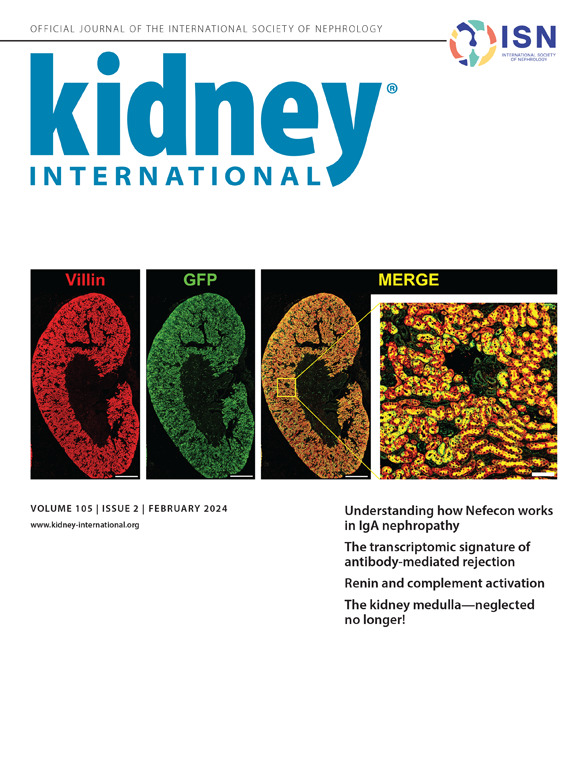JAG1的单等位致病变异导致常染色体显性小管间质肾病(ADTKD-JAG1)。
IF 12.6
1区 医学
Q1 UROLOGY & NEPHROLOGY
引用次数: 0
摘要
常染色体显性小管间质肾病(ADTKD)是一种常见的单基因肾病,通常在成年中期导致肾衰竭。它是由至少五个基因的致病变异引起的。然而,尽管对UMOD、MUC1、REN、HNF1B和SEC61A1进行了彻底筛查,仍有25 - 50%的家庭没有得到分子诊断。方法研究了来自英国基因组学100,000基因组计划的203个ADTK家族,以及病因不明的散发性肾脏疾病病例和慢性肾脏疾病5期病例。采用免疫标记、Western blotting、靶向RNA-seq和定量RT-PCR研究了携带与分离ADTKD相关的致病性JAG1变异的患者肾和/或尿上皮细胞(UREC)中JAG1的表达。通过分析内质网(ER)蛋白BiP在URECs中的表达水平来检测内质网(ER)应激。结果在3个ADTKD未解大家族中发现了与Alagille综合征相关的JAG1基因的sa致病性或可能致病性变异,在散发病例中发现了其他罕见变异。在两个家族中,Alagille综合征的诊断在第四代或第五代的一个婴儿中得到进一步证实,然而,23名患有孤立性肾衰竭的成年患者(以及肾活检患者的小管间质性肾炎)均没有明显的肝脏、胆管、心脏、眼睛或骨骼缺陷的迹象。JAG1表达研究以及内质网应激分析表明,尽管JAG1突变rna的表达值得注意,但小管间质性肾病并非由于异常蛋白的细胞毒性,而是由于单倍功能不全和功能丧失。结论sjag1致病变异可能与孤立性小管间质肾病相关,根据KDIGO指南,当JAG1变异导致符合ADTKD标准的孤立性慢性肾脏疾病时,应归类为ADTKD-JAG1。本文章由计算机程序翻译,如有差异,请以英文原文为准。
Mono-allelic pathogenic variants in JAG1 cause Autosomal Dominant Tubulo-interstitial Kidney Disease (ADTKD-JAG1).
INTRODUCTION
Autosomal dominant tubulointerstitial kidney disease (ADTKD) is a common monogenic kidney disease leading to kidney failure usually during mid adulthood. It is due to pathogenic variants in at least five genes. However, despite thorough screening of UMOD, MUC1, REN, HNF1B and SEC61A1, 25 to 50% of families remain without molecular diagnosis.
METHODS
Here, we investigated a cohort of 203 families with ADTK, as well as sporadic cases of kidney disease of unknown etiology and cases of chronic kidney disease stage 5 from the Genomics England 100,000 genomes project. Expression of JAG1 in kidney and/or urinary epithelial cell (UREC) lines from patients carrying a pathogenic JAG1 variant associated with isolated ADTKD was studied using immunolabelling, Western blotting, targeted RNA-seq and quantitative RT-PCR. Endoplasmic reticulum (ER) stress was tested by analyzing ER protein BiP expression levels in URECs.
RESULTS
A pathogenic or likely pathogenic variant in JAG1, the gene associated with Alagille syndrome, was identified in three large families with unsolved ADTKD, and additional rare variants were identified in sporadic cases. In two of the families, the diagnosis of Alagille syndrome was further established in one infant in the fourth or fifth generation, however none of the 23 adult patients affected with isolated kidney failure (and tubulointerstitial nephritis in individuals with available kidney biopsy) had overt sign of liver, bile duct, heart, eye, or skeletal defect. JAG1 expression studies as well ER stress analysis suggests that, despite a noteworthy expression of the JAG1 mutated RNAs, the tubulointerstitial renal disease was not due to cell toxicity of an abnormal protein, but rather to haploinsufficiency and loss of function.
CONCLUSIONS
JAG1 pathogenic variants can be associated with isolated tubulointerstitial nephropathy which, according to the KDIGO guidelines, should be classified as ADTKD-JAG1 when JAG1 variants lead to isolated chronic kidney disease that fulfils the criteria for ADTKD.
求助全文
通过发布文献求助,成功后即可免费获取论文全文。
去求助
来源期刊

Kidney international
医学-泌尿学与肾脏学
CiteScore
23.30
自引率
3.10%
发文量
490
审稿时长
3-6 weeks
期刊介绍:
Kidney International (KI), the official journal of the International Society of Nephrology, is led by Dr. Pierre Ronco (Paris, France) and stands as one of nephrology's most cited and esteemed publications worldwide.
KI provides exceptional benefits for both readers and authors, featuring highly cited original articles, focused reviews, cutting-edge imaging techniques, and lively discussions on controversial topics.
The journal is dedicated to kidney research, serving researchers, clinical investigators, and practicing nephrologists.
 求助内容:
求助内容: 应助结果提醒方式:
应助结果提醒方式:


